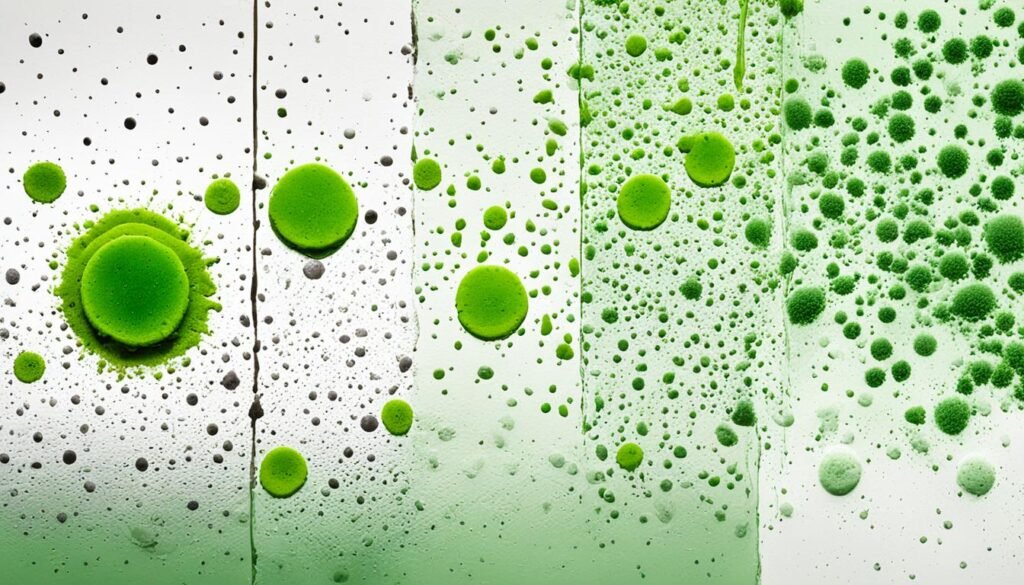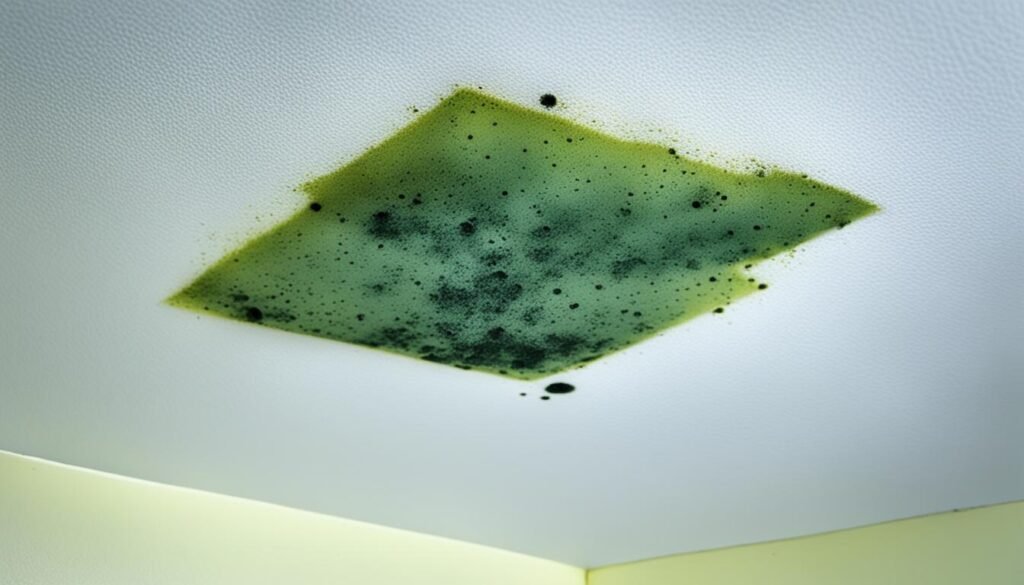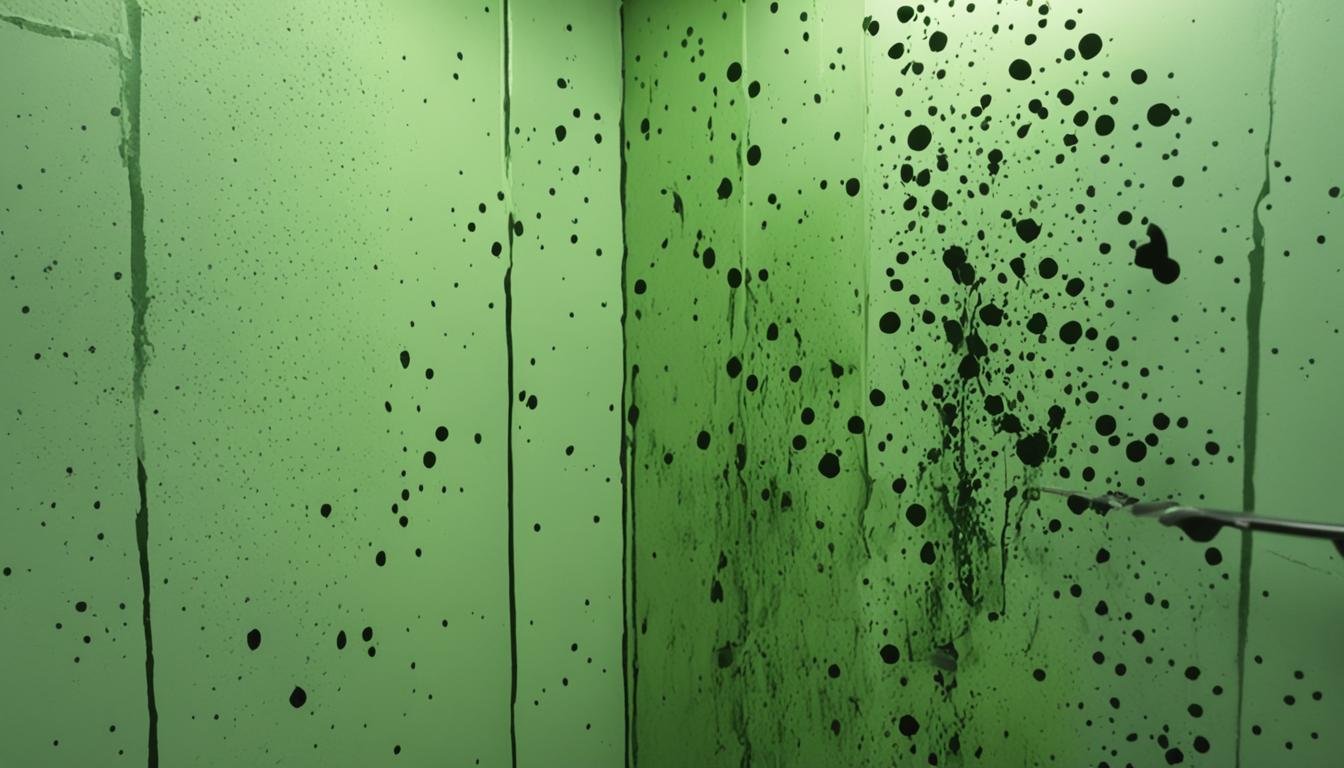Did you know that mold spores are almost everywhere, even in your home? These tiny fungi need moisture to grow and can affect the air you breathe. It’s important to spot mold early to keep your indoor air clean and stay healthy.
Key Takeaways
- Mold can produce musty odors and appear as fuzzy, discolored, or slimy patches that grow over time.
- Common sources of moisture that lead to mold growth include roof leaks, plumbing issues, damp basements, and poor ventilation.
- Exposure to mold can cause a range of health effects, from allergy-like symptoms to respiratory infections.
- Catching mold early allows for prompt remediation and prevention of further spread.
- Hiring a professional mold removal contractor is recommended for large-scale mold problems or for individuals with compromised health.
What is Mold and Where Does it Grow?
Mold is a fungus that loves wet, warm places. It can live inside homes and outside. Mold grows best in moist conditions and munches on things like wood, paper, and cloth. Common types of mold you might find indoors include Cladosporium, Penicillium, Aspergillus, Alternaria, Aureobasidium, Stachybotrys chartarum, and Trichoderma.
Types of Mold Found in Homes
Molds like damp places and can be found in bathrooms, basements, or on things hit by leaks. It’s good to know these areas, but finding out the exact mold type isn’t needed to get rid of it. This knowledge helps homeowners look for mold and fix any wet spots fast.
- Cladosporium – A common outdoor mold that can also grow indoors, Cladosporium is often found on textiles, wood, and painted surfaces.
- Penicillium – This mold can grow on a variety of materials, including food, paper, and fabrics, and is often associated with a musty odor.
- Aspergillus – A diverse genus of molds, Aspergillus can thrive in warm, damp environments and is known for its ability to produce toxins.
- Alternaria – Commonly found in bathrooms and other high-moisture areas, Alternaria can cause allergic reactions in some individuals.
- Aureobasidium – This mold can grow on wood, paint, and textiles, and is often found in bathrooms and around windows.
- Stachybotrys chartarum – Also known as “black mold,” Stachybotrys chartarum is a toxic mold that can grow on materials with high cellulose content, such as drywall and paper.
- Trichoderma – This mold can grow on wood, paper, and textiles, and is often associated with water damage and musty odors.
Finding mold in your home is a big deal. It can make you sick. Mold often causes allergies or breathing problems. Sometimes, it can even affect your brain. It’s key to fix any moisture problems and get rid of mold to keep your home healthy.

Early Signs of Mold in Your Home
Mold can sneak into any home and stay. But, watching for early signs helps you stop it. A musty, earthy smell is one early warning. This smell means mold is around, even if you don’t see it.
Look out for water stains, discoloration, or peeling wallpaper. These signs show mold might be there. Mold can also get in carpets and grow near water leaks from things like water heaters. If you’re sneezing a lot, eyes are itchy, or you’re getting a rash, it could be mold.
If your house has had water damage lately, it’s more likely to get mold. This could be from floods, leaks, or just high humidity. It’s important to fix any wet areas fast to stop mold from spreading.
Lumpy insulation in the attic might mean there’s mold. This happens when there are roof leaks and bad air flow. Mold can also grow in bathrooms with poor ventilation. It loves to hide in tile grout and other damp places.
Watch out for musty smells, signs of water damage, or if you’re suddenly not feeling well. These could all show mold is growing. Stay on top of fixing any leaks or keeping your house dry. This helps stop mold from getting worse.

“Mold can pose health hazards and should be treated promptly to prevent adverse health effects.”
Conclusion
Mold in your home can cause big health and building problems. It’s important to spot it early and act fast. Watch for smells, see if you notice any mold, or find water damage. These are early signs you might have a mold problem.
If you think there’s mold, getting help from pros like Water Damage Pros is wise. They can check your place and suggest how to get rid of the mold. Keeping your home dry, stopping leaks, and low humidity will stop mold growing. With these steps, you can have a healthy, mold-free house.
Call Water Damage Pros at 951-903-5429 for a mold check and advice. They’ve been helping Southern California for over 22 years. They’ll find and fix any mold issues in your home.
FAQ
What are the early signs of mold in a home?
Where does mold typically grow in homes?
What types of mold are commonly found in homes?
Why is it important to address mold issues quickly?
How can I get professional help with mold remediation?
Source Links
- https://www.health.ny.gov/publications/7287/
- https://www.healthline.com/health/mold-in-house
- https://www.realsimple.com/8-signs-there-may-be-mold-or-mildew-in-your-house-6753049
- https://jenkinsenvironmentalservices.com/early-signs-of-mold-in-a-house/
- https://greenorchardgroup.com/7-warning-signs-of-mold-in-your-home/
- https://www.thespruce.com/signs-of-mold-in-your-home-6834344
- https://www.spauldingdecon.com/blog/signs-of-mold
- https://www.bobvila.com/articles/signs-of-mold-in-house/
- https://www.airpf.com/signs-of-hidden-mold-in-the-house-and-how-to-find-them/
- https://www.everdrywisconsin.com/blog/what-are-the-first-signs-of-black-mold-in-your-home/
- https://www.gpinspect.com/article/home-mold-inspection/
- https://jselabs.com/blog/what-to-do-if-you-find-mold-in-your-house/


